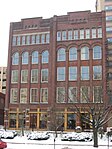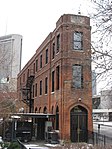OhioLINK
The Ohio Library and Information Network (OhioLINK) is a consortium of Ohio's college and university libraries and the State Library of Ohio. Serving more than 800,000 students, faculty, and staff at 88 institutions with 117 libraries, OhioLINK's membership includes 16 public universities, 23 community/technical colleges, 48 private colleges and the State Library of Ohio. OhioLINK serves faculty, students, staff and other researchers via campus-based integrated library systems, the OhioLINK central site, and Internet resources.OhioLINK's mission is to create a competitive advantage for Ohio's higher education community by cooperatively and cost-effectively acquiring, providing access to, and preserving an expanding array of print and digital scholarly resources in order to advance teaching, learning, research, and the growth of Ohio's knowledge-based economy.OhioLINK offers these main digital collections and services, some of which are open access: The Central Catalog, a union catalog of the combined member library collections A collection of research databases The EJC or Electronic Journal Center, a multi-publisher article database The Digital Resource Commons The EBC or Electronic Book Center, a multi-publisher book collection The Finding Aid Repository (Open Access) The Digital Music Center The ETD or Electronic Theses and Dissertations Center (Open Access). eTutoring, a collaborative online tutoring platform for participating member institutions The OhioLINK Open Course Content Library for Open Educational Resources (Open Access) Through a peer-to-peer print sharing network with participating Ohio public libraries in the SearchOhio Network, OhioLINK students, faculty and staff can request public library materials and vice versa. Digital preservation of locally ingested and created items such as electronic theses and dissertations using the Rosetta product from Ex Libris. OhioLINK also supports the member libraries which administer the Regional Book Depository program. These five high-density remote storage facilities are each administered by a member library and the materials housed there circulate through the OhioLINK print lending program.
Excerpt from the Wikipedia article OhioLINK (License: CC BY-SA 3.0, Authors).OhioLINK
East Chestnut Street, Columbus
Geographical coordinates (GPS) Address Nearby Places Show on map
Geographical coordinates (GPS)
| Latitude | Longitude |
|---|---|
| N 39.967508 ° | E -83.000079 ° |
Address
East Chestnut Street 33
43215 Columbus
Ohio, United States
Open on Google Maps










